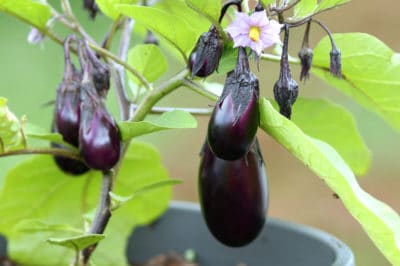Pot Size
You’ll want a pot that’s large enough to provide enough room and air circulation for the roots of your eggplant. The pot also needs drainage holes on the bottom, preventing fungus and mildew from growing in the soil. Since some eggplant varieties can grow up to 4-feet high, choose a pot size of at least 5 gallons. Your eggplant bushes need pots from 12 to 14 inches in diameter. If you choose a 20-inch pot, you can plant three compact eggplant varieties in it.
Pot Style
When shopping for pots, you’ll find that many of them are either glazed or unglazed. The colors and designs on glazed pots are both ornamental and practical styles for eggplants.
- Glazed pots retain water, so you don’t have to water as often, but make sure they have sufficient drainage.
- Unglazed clay pots absorb water, so your eggplants need water a couple of times per day. They also retain heat, which makes them a good choice for cooler climates.
Steps for Planting Eggplant in Pots
For a successful eggplant harvest, follow these steps to plant your eggplants in pots:
- Clean the inside of the pot with soap and water. This will remove any bacteria or insect eggs that could be inside.
- Mix potting soil and sand together, using a 2 to 1 ratio. The sand helps with drainage to prevent mildew and fungus growth.
- Fill the pot with your soil mixture without pressing it down. The soil should be loose.
- Plant your eggplant seedling in the pot, covering the root ball.
- Water your seedling thoroughly.
Support the Eggplant
As your eggplant grows, place a tomato cage around the plant, or stake it for support. Eggplant fruit is heavy, and pulls the stems down, as it grows larger. This can result is broken branches and bruised fruit.
